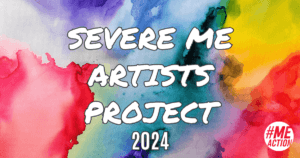Earlier this month #MEAction collaborated with Patient-Led Research Collaborative (PLRC) to suggest changes that the U.S. Department of Labor (DOL) should make in order to better track disability due to chronic illnesses such as ME/CFS and Long COVID in its regular surveys of disability employment issues.
We provided feedback on ways to improve questions on topics related to work history, barriers to employment, job accommodations, commuting and work hours, financial assistance and specific questions on tracking Long COVID.
#MEAction and PLRC were responding to a request for information from DOL’s Office of Disability Employment Policy on recommending changes and additions to the Current Population Survey Disability Supplement which is expected to next be conducted by the Bureau of Labor Statistics (BLS) and the Census Bureau in 2024.
Recommended changes to CPS Disability Supplement
We recommended that the CPS Disability Supplement should better capture the experiences of chronically ill workers. As the CPS is now, those who would be given the Disability Supplement do not encompass all disabled people. People who have symptoms that interfere with their work, like post-exertional malaise (the worsening of symptoms following exertion), fatigue, and insomnia, may not answer “Yes” to one of the six questions that aim to classify people with disabilities in the CPS. In order to properly assess the experiences of all disabled people in the US, it is critical to expand these questions and to ensure that all disabled people are eligible to answer the Disability Supplement.
Our recommendations included making additions/changes to questions that capture/measure:
- The frequency, not just severity, of functional impairment due to disabling ill health,
- A person’s reduction in hours due to their disability,
- If a person left a job due to lack of accommodations,
- Barriers to employment for the currently employed and those who do not meet the CPS definition of disability,
- The difference between accommodations that are “changes to work tasks” and those that are “changes in job schedule,”
- Those who wanted to ask for a job accommodation but didn’t either because they weren’t sure how to request, or didn’t believe the request would be accommodated,
- Changes to tele-work/work-at-home before or after the COVID-19 pandemic,
- Additional types of financial assistance programs received including SNAP, TANF, and distinguishing between short-term, employer-sponsored, and individually purchased disability insurance,
- Whether a person has had a COVID-19 infection, experienced Long COVID symptoms and how those symptoms have impacted their ability to work.
Our complete response to the DOL request for information can be viewed here.
PLRC and #MEAction recommendations are based upon PLRC’s experience in conducting surveys of the Long COVID community, #MEAction’s long-standing experience with barriers to work faced by people with ME/CFS, and our shared recognition of the need for proper measurement of Long COVID, ME/CFS and other infection-associated chronic illnesses impact on work.
Other advocacy to improve reporting on the impact of chronic illness
In our April meeting with DOL, #MEAction highlighted the problem of the lack of reporting on the impact of infection-associated chronic illness on work. At the time we recommended that the Bureau of Labor Statistics should request the Census Bureau to add PLRC questions on Long COVID to the Current Population Survey to better track prevalence and its impacts on work. Our joint response to the DOL request for information builds upon this initial advocacy.
In addition to outreach to DOL, PLRC was also successful in advocating to CDC to add questions on Long COVID to the Household Pulse Survey. That change allowed CDC to release new prevalence data in June showing that “nearly one in five American adults who have had COVID-19 still have Long COVID.”






1 thought on “How Dept. of Labor can better track disability from chronic illness”
I’m very proud of all who were able to participate in #MillionsMissing. It was interesting to see so many very young folks and few elderly like myself. I’m about to turn 83 and suddenly overnight became ill with ME starting with a bout of vertigo. The dizziness went on for years. It wasn’t until I saw an MD who practiced Chinese Medicine and did acupuncture on me that I was rid of the chronic dizziness. I had many symptoms. If you have a copy of David Bell’s book, he included a long list of symptoms that some folks suffered thru including me. I finally found Dr. Lapp whose treatment plan was very helpful.
I had to be very careful to rest a lot and take frequent breaks. I actually worked for another 8 years after I contracted ME/CFS. I had work I thoroughly enjoyed and I think that helped. I never had the severe form of ME thankfully. Dr. Lapp classified mine as moderate. But it changed my life. The hardest thing to cope with was people’s unbelief. Even to this day, that unbelief exists in some members of my family. So after nearly 40 years, I hope that something is found to really help those who have severe ME. Living with that is no life.
I used to wish that all the doctors and others in the medical field who didn’t believe would get sick with the severe form so that they could finally understand.
Comments are closed.